Please visit Marketing Land for the full article.
Friday, April 29, 2016
Marketing Day: IAB's LEAN scoring, Echo/Alexa sales & LinkedIn's earnings report
Please visit Marketing Land for the full article.
Online Marketing News: Short Attention Spans, Google Feed Rules, Starbucks Emojis
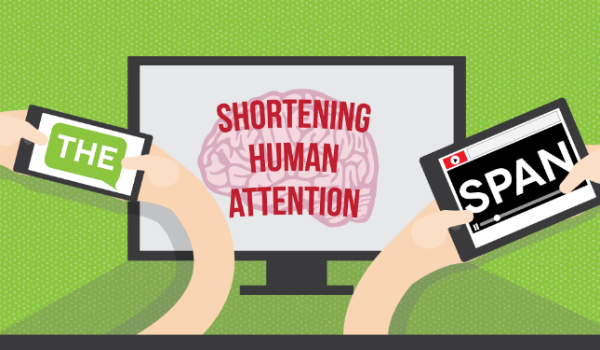

The Shortening Human Attention Span (And What it Means for Marketers) [Infographic]
Down from 12 seconds in 2000, the average human attention span is now 8.25 seconds. That leaves marketers with very little time to make a meaningful impression. But, don't sweat it too much. This infographic has some solid tips on how to capture and hold the attention of your audience, like using clear and brief messaging and telling your audience a story. Social Media Today
Google adds Merchant Center Feed Rules to make formatting shopping feeds easier
For a long time, Google shopping feeds have been a bump in the road for digital advertisers. So much so that there's a whole industry dedicated to helping advertisers manage their shopping feeds. On Tuesday, Google announced a new feature in the Merchant Center -- Merchant Center Feed Rules, that will help advertisers fix errors themselves in a simple way. Search Engine Land
Starbucks launched its own keyboard app so you can text emojis of unicorns drinking coffee
Starbucks is now allowing users to send unicorn and coffee emojis to their contacts. That's it folks, the world is complete. The app was released under a partnership with Snaps Media, and is Starbucks' first consumer app that is focused on entertaining their audience. What could this mean for other brands? I'm willing to bet we'll see more custom emoji keyboards in the near future. TechCrunch
Facebook's mobile ad revenue grew by 76% to $4.26 billion in Q1 2016
Facebook reportedly grew revenue in Q1 of 2016, which is a contrast to reports issued by Twitter and Apple with revenue reportedly being less than expected. Not only is mobile ad revenue up, but Facebook's daily audience grew by 16%, with money made from each audience member increasing by 33%. This post is full of useful information from that report, and some highly entertaining gifs to boot. Marketing Land
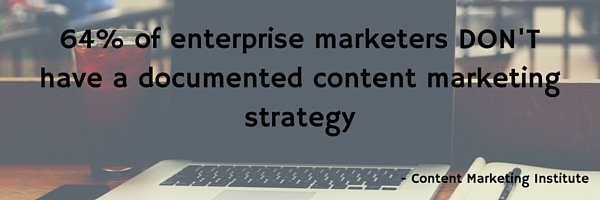
Twitter Q1 2016 Revenue Falls Short of Analysts' Projections
Twitter reported that while revenue was up 36% YOY for Q1, the $595 million fell short of analysts predictions. According to SocialTimes, "Twitter reported a GAAP (generally accepted accounting principles) net loss of $80 million, or 12 cents per share, less than one-half the company's net loss in the first quarter of 2015." SocialTimes
Marketers Choose Responsive Email Templates Over Fluid Hybrid Design
New research shows that marketing professionals worldwide are overwhelmingly choosing to use responsive email templates (56.9%) over fluid hybrid design (7.9%). Interestingly, 19.9% are using both types of templates, and 15.2% aren't using either. Designing for mobile first may sound like a trendy marketing idea, but smart marketers know that if your emails don't look great on mobile, they aren't nearly as effective. eMarketer
What were your top online marketing news stories this week?
I'll be back next week with more online marketing news! In the meantime, send your thoughts and ideas to me @Tiffani_Allen or @toprank!
The post Online Marketing News: Short Attention Spans, Google Feed Rules, Starbucks Emojis appeared first on Online Marketing Blog - TopRank®.
Is Your 'About' Page Ruining Your Chances of Getting a Referral?
Is Your 'About' Page Ruining Your Chances of Getting a Referral? written by Guest Post read more at Duct Tape Marketing

photo credit: Canva
Every business has a website, right?
It is your shop window; the place where people learn about you, your brand and the products or services that you're selling.
And due to our heavy online usage habits, it's also the place that dictates the sustainability of a company.
You see, every business needs to be liked.
According to the New York Times, 65% of new business comes from referrals.
Meaning that almost two thirds of consumers make a purchase because someone they know has recommended a particular product or service.
On your website, there's one page that's more important to securing referrals than all the others.
It's your 'about' page.
In this post, I'll tell explain exactly why this page is so important.
I'll give you some simple pointers that'll help you create a killer piece of content to sit in this area of your site.
[Content that will win you business both now and in the future.]
And finally, I'll also reveal how to tell if your 'about' page is failing you.
The 'about' page – what's the big deal?
This is where your prospective customers get to know you – the place where they form those all-important first impressions.
And it's these very impressions that will make or break your chances of getting a referral.
It's a question of pure logic.
As consumers, we use the extra details that we learn about a brand on this page as backup in case we're undecided about whether to buy something.
A good 'about' page pushes a lead further down a sales funnel, either consciously or sub-consciously.
If we've subsequently given our prospect a great service, we build on those good early impressions (again, either consciously or sub-consciously).
Then, it's only now, at the end of the customer journey, that we potentially reap the ultimate reward: the referral.
As you surely know, this is the best and most powerful form of marketing there is.
And it's all thanks to the first step: the 'about' page.
However, creating a quality piece of content in this area clearly isn't straightforward, otherwise more businesses would do it.
Despite the importance of the 'about' page, this is the section of a website where a company traditionally drones on about how many years they've been operating.
Or how many offices they have scattered across the world.
A good 'about' page will empower your brand and make you memorable.
It's funny.
For many business owners who are tasked with creating content for their websites, the 'about' page is usually given low priority status.
Yet this is a huge mistake – it's ignoring one of the oldest clichés in the book: that people buy from people.
An 'about' page is critical to a website's success.
It's your chance to step away from the boardroom and reveal the people behind your brand.
But an 'about' page is about much more than just providing an opportunity for chitter-chatter.
This is about creating copy that will help establish some of the main pillars that people need to see and feel before they part with their hard-earned cash.
We're talking about factors such as trust, integrity, authenticity, personality and morality.
In summary, your 'about' page needs to 'wow' visitors and impel them to recommend you to the people in their lives.
After all, referrals are how you create a memorable brand; one that will enjoy a stable future.
So, what can you do about your page?
For starters, don't be self-obsessed.
You have to put yourself in a visitor's shoes.
Suppose that you've just landed on a website.
What do you need to hear in order to convince you to make a transaction?
Which brands do you admire?
Which businesses do you trust, admire and respect?
Chances are, they've convinced you through having a clear and consistent content strategy.
To that end, ironically, your 'about' page is more about 'them' than it is about you.
Take time to establish your core values.
Think about your customer pain points (why are they even considering buying from you in the first place?).
Then map out your content and make sure that everything you're saying is relevant to the customer.
With all due respect, all things being equal, they don't care whether you've been trading for 10 years or 10 minutes.
They don't care about industry awards they've never heard of.
All they care about is what they can get out of their time on your site.
Can they get what they want?
To that end, what you have to say about your business isn't really the point.
By contrast, you should actually focus on what your visitors need to get out of their time on this section of your website.
Are you leaving money on the table?
Here's a quick X-step process to find out whether you could do a better job with your 'about' page.
[Hint: you'll need Google Analytics set up with your website.]
Step 1: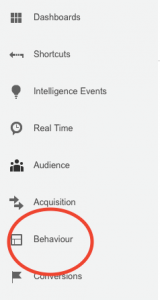
After opening up your Google Analytics account, click on Behavior.
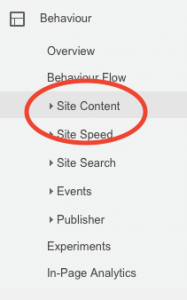 Step 2:
Step 2:
Now click on All Content.
Step 3:
You should automatically land on the first option: All Pages.
What you're looking at is a breakdown of what people are doing on each of the pages on your website.
Now find your 'about' page.
Most businesses will see this in one of the top 10 most-visited pages on their website, but if it's not there, then go through the other pages until you find it.
Step 4:
Once you've found the stats for your page, look at the column under bounce rate.
Step 5 [the analysis]:
As you may or may not know, your bounce rate reveals how many people are leaving a certain page without taking any other action.
In other words, they're either not finding what want or aren't liking what they see.
Clearly, the lower the bounce rate is for your 'about' page, the better the job it's doing.
If your bounce rate for your 'about' page was 100%, everyone's leaving after reading your copy and you're doing terrible.
If it's 0%, your 'about' page has definitely piqued their interest and you're doing great.
But those examples aren't that helpful.
They're too extreme.
So the big question is, what bounce rate should you be aiming for?
In truth, there's no clear right or wrong answer.
Having said that, research does tend to indicate that a bounce rate of 25-30% is very good (and probably as good as it'll get).
Most businesses will probably see a bounce rate in the region of 55-85%.
And it's those companies, the vast majority, who can improve their 'about' page.
All the top entrepreneurs always say that it's the little details that yield the big results.
So surely it's worth putting some effort into your 'about' page?
 Matt Press is an experienced copywriter who has written for some of the UK's biggest brands, such as Sky, Three and Vodafone. He now runs his own content marketing agency, Splash Copywriters.
Matt Press is an experienced copywriter who has written for some of the UK's biggest brands, such as Sky, Three and Vodafone. He now runs his own content marketing agency, Splash Copywriters.
Thursday, April 28, 2016
Amazon reports profitable Q1 to beat expectations
Please visit Marketing Land for the full article.
Wednesday, April 27, 2016
10 Must-Know Facebook Ads Tips & Features
It's no secret that paid social is drastically on the rise. Social advertising spend jumped 50% year-over-year in the last quarter of 2015. Social media ad revenue is expected to reach $35.90 billion by 2017, reaching a staggering 16% of the total global digital ad market.
Facebook (including Instagram) unsurprisingly comprises a big piece of this pie, making up an estimated 65.5% of all 2015 social ad spend. This is driven by changes in their CPC model, launch of Instagram ads & the addition of powerful new features.
This post will arm you with 10 important tips & features to ensure you're getting the most out of this channel.
1. Facebook Lead Ads
One of the most recent campaign types added by Facebook are Lead Ads. This campaign type allows advertisers to collect lead data without a landing page and directly through a form without leaving Facebook.
Some early advertisers found Lead Ads to result in a 4x reduction to their CPL (according to Facebook).
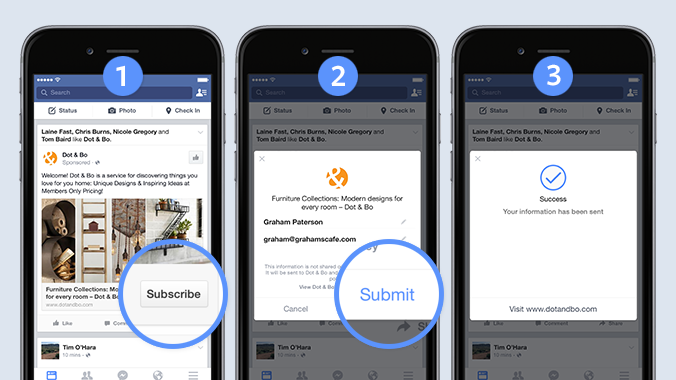
To get started with Lead Ads, simply:
1. Create a new campaign with the “Lead Generation” objective
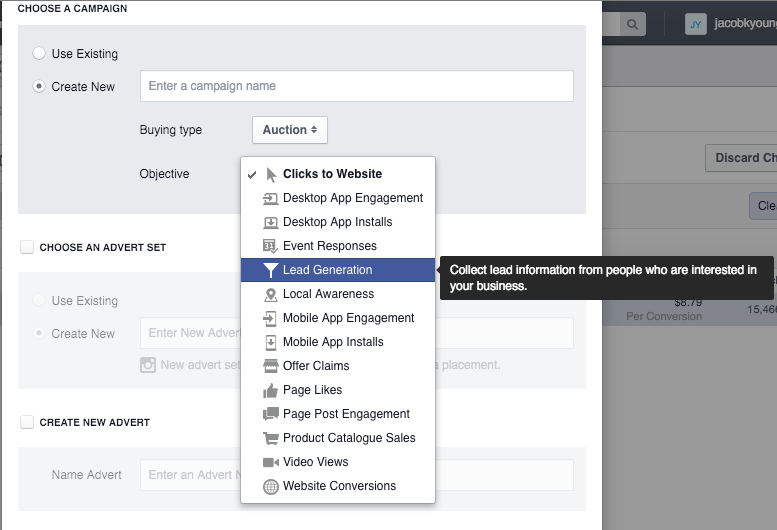
2. Build out your campaign/advert set, as you would for any campaign
3. Create your lead form at the advert level

4. Choose the questions you'd like added and optionally add up to three custom questions
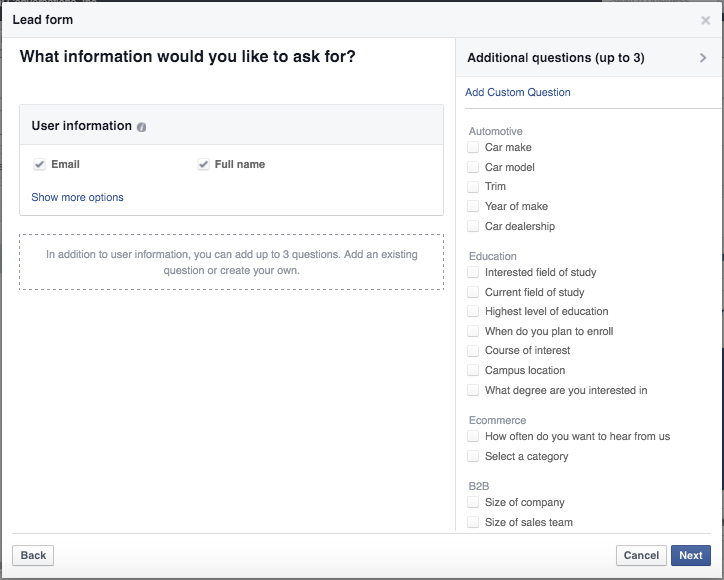
5. Link to your privacy policy, add your disclaimer and destination URL
6. Customize your form
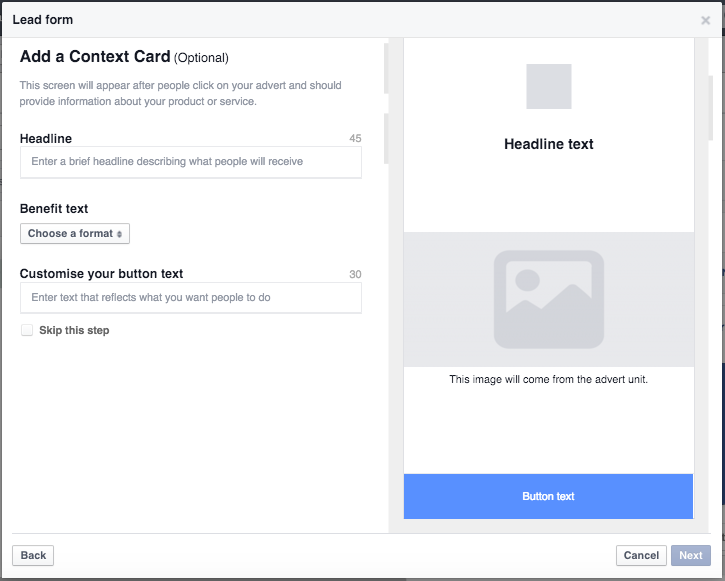
7. Preview then create your form
Now you're ready to get started with Facebook's newest and most powerful lead generation tool.
Tip: Twitter has had this campaign type for years, they call it Twitter Lead Cards.
2. Reporting, Reporting, Reporting
Some of the biggest wins are always found within the reporting section. One of the most important parts of reporting is the 'Breakdown' section.
- Are your mobile placements converting?
- What age group has the strongest CPA?
- What regions aren't converting?
- What gender is responding to your adverts?
These are all important questions that can be answered under the 'Breakdown' drop-down.

In this example, the Instagram placement converted a near 500% better than mobile news feed placement, at a fraction of the CPA. Knowing this, we'd shift more spend to Instagram and remove budget from the mobile news feed placement to maximize performance at our budget (if there's volume available).
3. Attribution models
It's important to understand Facebook's attribution models, where to change the view and what makes sense for your conversion goal. These are the 'rules' for how each conversion is counted, in regards to the timeframe after an interaction with your advert and the method of the interaction (click or view).
This is important to take note of so you have a clear understanding of the value of your conversions and how they compare to the other networks you may be running.
Within 'Manage adverts', the option to change the attribution model can be found under 'Columns' > 'Customize Columns…' > 'Change Attribution Window'.

4. Test Instagram
Since September 2015, Instagram placements have been made public in 30+ countries within the Facebook Ads Dashboard. Getting started with this is as simple as connecting an Instagram account and choosing the Instagram placement.
Break out some test budget and see how this placement compares.
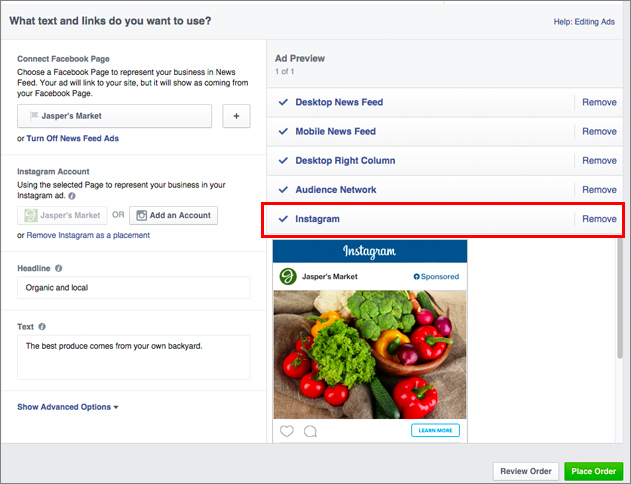
5. Lookalike audiences
I've found lookalike audiences to be one of the most effective targeting methods on paid social.
A lookalike audience is a targeting criteria where Facebook generates an audience of user who are similar to your current customers or audience.
This audience can be based off an email list, segments of your Facebook Pixel or any conversion goals you have set up. Facebook matches these users with Facebook profiles then finds similarities in demographics, interests, behaviors, etc. Lastly, Facebook uses these finding to generate a list of similar Facebook users which you can target in your campaigns.
Learn how to create a lookalike audience here.
6. Keep an eye on Facebook's location options
An often overlooked targeting criteria is Facebook's more granular location targeting options. It's important to keep this in mind while creating your campaigns and use the targeting option that makes the most sense for your business.

Are you trying to target people living in a specific city, or all people within this city? These are two very different targets.
Take for example, a local service business operating only in downtown SF. You wouldn't want to be targeting people visiting for the weekend, or commuting in for work.
7. Speak to your audience
With Facebook's granular targeting methods, in most cases you know who you're speaking to (at least the interest, behaviours, etc. that define your audience).
Use this knowledge to tie copy and creative closely with each specific audience you're targeting.
Targeting a recent homebuyer? How about something like “Your new home would be complete with [Brand Name's] contemporary/ modern furniture line”.
8. Remarketing
All digital marketers know the importance of remarketing, so don't level this out of your Facebook Ads strategy be left out.
Make sure to take advantage of Facebook's audience segmentation options, where you can include/exclude specific pages & domains, as well as choose the remarketing window length.
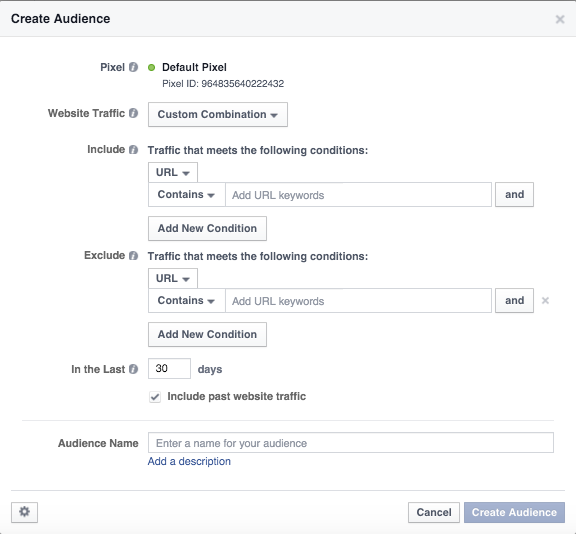
This feature allows advertisers to remarket specific products to users who've previously viewed or added them to their cart. The creative and copy of your ads will dynamically change based on what products your visitors have viewed.
9. Test multiple creative and copy
Always test many creative and copy variants to see which ones resonate best with your audience. Facebook will optimize ad serving based on performance and your conversion goal.
An interesting and relatively new creative type I recommend testing is the 'Carousel', which allows you to fit multiple images and links into a single creative.
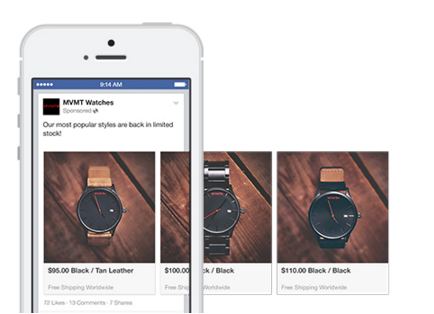
This creative type has been found to reduce your CPA by about 30-50% & decrease your CPC by 20-30% (according to Facebook).
Use this creative type to:
- Showcase multiple products
- Highlight multiple features
- Create a larger canvas
- Outline benefits
- Tell your brand's story
Tip: Don't forget to run a statistical significance test to see if the improvement you're seeing is indeed valid and not just by chance.
10. Breakout campaigns by placement
The different placements offered by Facebook perform very differently. It's important to keep an eye on their performance and where your spend is being directed (details of how to do this are found in #2 above).
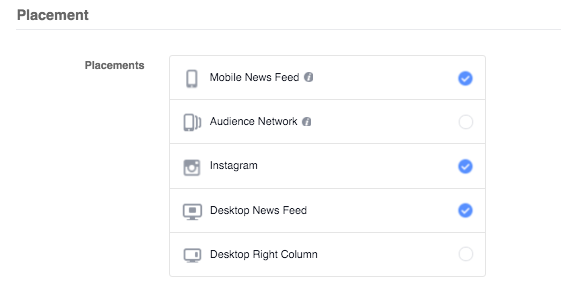
When optimizing for clicks, I find most of your budget will get pushed to mobile or audience network (since these have the most effective CPC), however these placements may typically not have the best overall performance.
In most cases, I find it makes sense to break out your campaigns by placement (or at least mobile vs. desktop). This is especially true if you're setting manual bids, or if your campaign is set to optimize for clicks.
Conclusion
I hope you find these Facebook Advertising tips & features useful. If you have any questions or additional tips/features that you think merit discussion, let us know if the comments section, or email me at jacob@cleverzebo.com.
About the Author: This guest post is written by Jacob Young, world-traveling digital nomad and Senior Manager, Ad Operations at Clever Zebo. Currently writing from the Co-Work office in Sayulita, Mexico. To learn how Clever Zebo can jumpstart your paid social efforts, shoot us a note at igor@cleverzebo.com or Tweet us at @CleverZebo.
7 Ways to Step Up Your Email Marketing Game in 2016
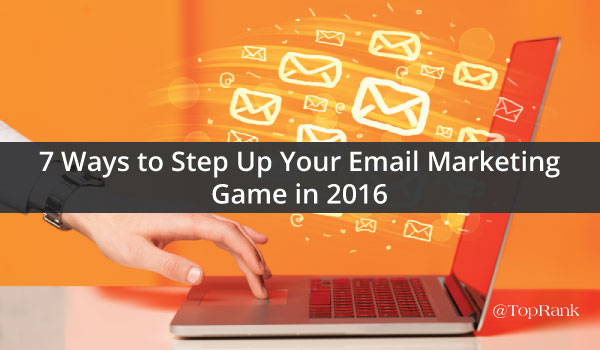
Email marketing is a great, cost-effective way to engage prospective customers and nurture relationships with current customers. And email is actually welcomed by consumers. In fact, recent research has found that a whopping 91% of Americans say they want to receive promo emails.
But let's face it. With email being one of the most common forms of communication these days, your customers inboxes are most likely a little full. And it's time for you to step up your game if you want to continue connecting with subscribers and encouraging them to do business with you.
While we're almost halfway through 2016, there's still time to make the most of the latest email marketing tricks and trends. Below are seven considerations for creating an emails that will resonate with your audience and help you up your game.
#1 – Remember: It's All About Mobile
This one may seem like a bit of a no-brainer, but nonetheless it needs to be mentioned. Mobile has become an increasingly important consideration for website designers and digital marketers. People rely on their mobile devices for a lot of things–and email is certainly one of them. In fact, studies show that 55% of email is now opened on a mobile device.
Typically, the content should be focused and not too text heavy. But the most important thing to remember is that people want fast loading times. So, if you're using large video or image files, make sure they'll open quickly and easily.
#2 – Personalize Your Message
A one-size-fits-all approach to email marketing is simply not reasonable these days. Your email recipients are interested in messages that are focused on their personal tastes and preferences–addressing them by their first name in the opening is not good enough. Use data insights to create different messaging for individual target groups.
For example, Pinterest does an excellent job at personalization. Every week, I can count on receiving an email with suggested pins or boards to follow that are based on my interests and behaviors on the platform.
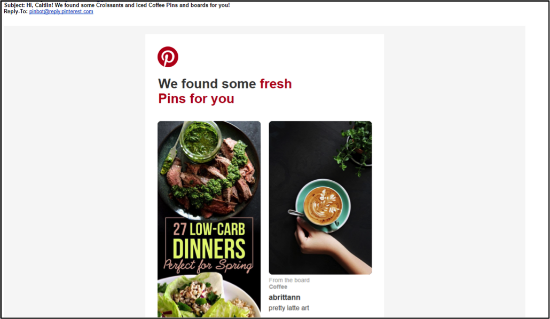
Can you tell I'm attempting a diet?
#3 – Understand the “Why”
Spend some time actually thinking about why your subscribers actually open an email. An enticing discount or a new product launch may not be the only reason they click. Think about who your customer is, what they're usually looking for, what's important to them and what season it is. In addition, think about what device they are looking on. Is it a tablet? Smartphone? Basically, dig into the psychology of your customers. This will directly correlate with your ability to personalize your messaging.
#4 – Explore Automation
Automated email campaigns allow you to use a triggering event such as an asset download, contact form fill out or a webinar signup to kick-off a tailored series of emails. Your monthly newsletters or specialty campaigns are definitely important components of your overall email marketing strategy. But email automation can be a very powerful tool that can help you nurture relationships and drive customers to a desired outcome.
For example, if you're hosting an in-person event or webinar, email automation can be used as a way to communicate with attendees before, during and after the event. Content delivered before or during the event would include information on accommodations or the event schedule. Content delivered after the event ends would include special access to event assets and presentations, or perhaps direct them or information on another upcoming event they're interested in.
Determine your triggering events and then create an automation workflow that details what you'll send to them throughout the automation campaign. Here's an example:
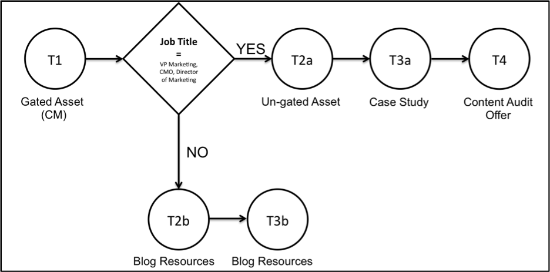
#5 – Add Dynamic & Interactive Content
Dynamic and interactive content is something that is pretty new to the email marketing world. Dynamic options could include changing the content of an email based on location or weather, and interactive content could be features like animations or carousel elements. Software tools that can help you do this type of content are HubSpot and MovableInk.
#6 – Use a Lightbox to Grow Your Email List
Lightboxes–or pop-ups–can be an effective way to quickly grow your email list. While some may think they're a bit annoying, lightbox pop-ups bring a connection option to your audience–rather than relying on them to search it out.
If you go this route, make something that's unique rather than using a generic template. Also, use active language that will compel people to do what you're asking. Here's an example from HouseLogic, a home improvement tips and tricks website operated by the National Association of Realtors. They know why their audience is there and uses visuals to entice a sign up.
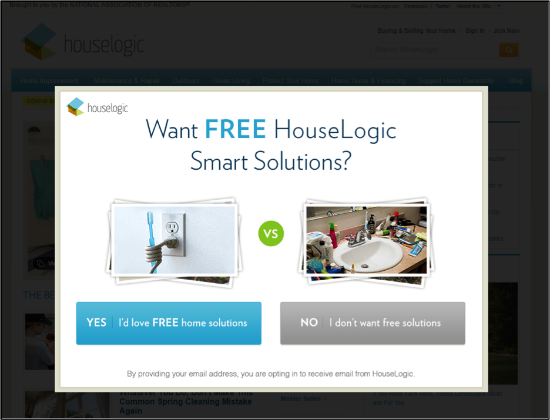
#7 – Implement Tracking
Having the proper tracking in place so you can gather data and pull insights from your email campaign is crucial. (And really tracking should be an important part of your entire digital marketing campaign.) If you're using Google Analytics, add campaign parameters to the source URL to get a better idea of how many people are coming to your website from email. Check out Google's Email Tracking – Measurement Protocol for step-by-step instructions.
What are some of your email marketing best practices? Tell us in the comments section below.
Header image via Shutterstock
![]()
Gain a competitive advantage by subscribing to the
TopRank® Online Marketing Newsletter.
© Online Marketing Blog - TopRank®, 2016. |
7 Ways to Step Up Your Email Marketing Game in 2016 | http://www.toprankblog.com
The post 7 Ways to Step Up Your Email Marketing Game in 2016 appeared first on Online Marketing Blog - TopRank®.
Facebook's mobile ad revenue grew by 76% to $4.26 billion in Q1 2016
Please visit Marketing Land for the full article.